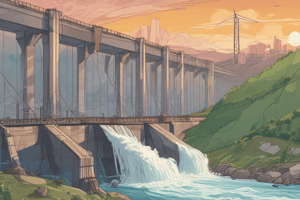Podcast
Questions and Answers
What is the primary force behind the movement of water from high to low elevation?
What is the primary force behind the movement of water from high to low elevation?
- Thermal energy
- Wind
- Gravity (correct)
- Kinetic energy
How has hydropower been historically used?
How has hydropower been historically used?
- To power machines that break and process ore (correct)
- To power vehicles
- Only for generating electricity
- Exclusively for papermaking
What is the term used to describe the production of electricity using hydropower?
What is the term used to describe the production of electricity using hydropower?
- Hydroelectric power (correct)
- Kinetic energy production
- Mechanical energy generation
- Turbine energy production
What is the root word of 'hydropower' that means water?
What is the root word of 'hydropower' that means water?
What was a significant invention that led to the production of electricity using hydropower?
What was a significant invention that led to the production of electricity using hydropower?
What is one of the advantages of using hydroelectric power in the United States?
What is one of the advantages of using hydroelectric power in the United States?
What is a negative impact of damming waterways on local ecosystems?
What is a negative impact of damming waterways on local ecosystems?
What is one way to mitigate the problem of disrupting the natural flow of the river?
What is one way to mitigate the problem of disrupting the natural flow of the river?
What is a drawback of creating reservoirs for hydroelectric power?
What is a drawback of creating reservoirs for hydroelectric power?
Why is hydroelectric power considered cost-effective?
Why is hydroelectric power considered cost-effective?
What percentage of the total clean energy produced in the United States comes from hydroelectric power?
What percentage of the total clean energy produced in the United States comes from hydroelectric power?
What is the primary source of water for hydroelectric power plants?
What is the primary source of water for hydroelectric power plants?
What is the purpose of building dams in hydroelectric power plants?
What is the purpose of building dams in hydroelectric power plants?
What is the benefit of hydroelectric power in terms of climate change?
What is the benefit of hydroelectric power in terms of climate change?
How does the turbine generate electricity in a hydroelectric power plant?
How does the turbine generate electricity in a hydroelectric power plant?
Flashcards are hidden until you start studying
Study Notes
What is Hydropower?
- Hydropower is the natural force created by water as it moves from areas of high elevation to areas of low elevation, producing kinetic energy.
Historical Use of Hydropower
- Hydropower has been used historically to power mills that milled wheat into flour, to power hammers that break and process ore, and in papermaking.
Modern Use of Hydropower
- Hydropower is used to produce electricity, with the U.S. using hydroelectric power to produce 7.3% of its total generated electricity and 37% of its total clean energy.
Electricity Generation
- To produce electricity using water, there must be a flow of water and a turbine connected to an electrical generator.
- The water cycle provides the flow of water, with water evaporating, condensing, and falling back to Earth as precipitation.
- Rivers and streams flow from areas of high elevation to areas of low elevation, collecting into larger bodies of water and eventually penetrating the soil or flowing into the ocean.
- Hydroelectric power plants are built on rivers, with dams creating artificial bodies of stored water (reservoirs) to control the flow of water.
- Water flows through holes in the dam (penstock), turning a turbine and powering a generator, producing electricity.
Hydropower Pros and Cons
Benefits of Hydropower
- Hydropower is a renewable resource, as water is constantly recycled in the water cycle.
- It is a clean energy resource, without the use of fossil fuels that pollute the atmosphere and contribute to climate change.
- Hydropower is flexible, cost-effective, and can provide a local power source.
Disadvantages of Hydropower
- Damming of waterways can disrupt local ecosystems, change water temperatures, and affect plant and animal species.
- Creating reservoirs can contribute to greenhouse gas emissions and disrupt the natural flow of rivers.
- Fish ladders have been invented to mitigate problems with migratory fish.
- Damming can affect organisms that rely on higher water levels or specific flows of water.
Studying That Suits You
Use AI to generate personalized quizzes and flashcards to suit your learning preferences.




